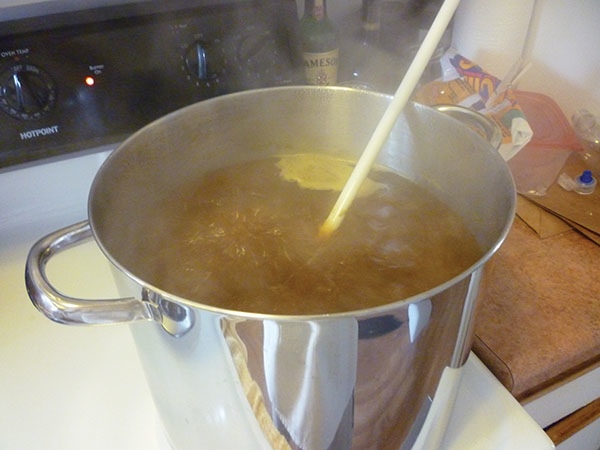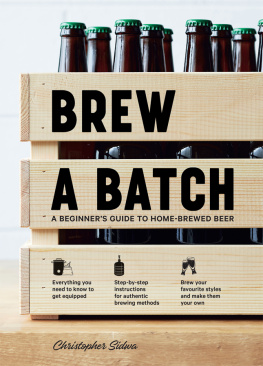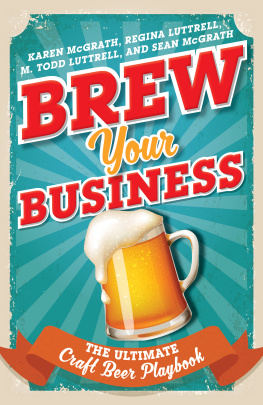Introduction

Youre ready to take the home-brewing plunge: youve frequented your local breweries and sampled all of the beers they have to offer, youve chatted up bartenders and the workers at your local liquor store, and youve done preliminary research on ingredients, equipment, and brewing styles. Maybe youre just a burgeoning beer fan whos looking for a new hobby, and youve heard so much about this whole home-brewing thing that youve decided to give it a shot. Or maybe youre somewhere in between: you know the difference between an India pale ale (IPA) and a porter, but youre still a little green about home brewing.
Regardless of where you find yourself on the spectrum, this book will show you that home-brewed bottles of your own endlessly customizable beer are well within your reach. Itll take you through every step of the process, from choosing a style to brew and getting your hands on the necessary equipment to the excitement of brewing day and cracking open that very first bottle of home brew. Its designed to be your constant companion, giving you background info on the history of beer itself, strategies on tweaking and adjusting your batches and recipes to get the exact beer you want, and advice on branding your beers and taking your hobby to the next level, all while incorporating practical tips from other home brewers around the country.
As far as hobbies go, home brewing is pretty inexpensive and one of the best ways to make friends that Ive encountered. What better way to break the ice at a party than by bringing a six-pack of your own home-brewed witbier? As long as you keep sanitization your primary concern, the hardest part of home brewing is the waiting. Only brewing day and bottling day require hands-on activity; otherwise, time is the only thing keeping you from cracking open a cold one of your very own.
The groundwork of home brewing is pretty easy to master, but once youve gotten a few batches under your belt, there are a number of additional steps you can take to continue enhancing your creations, including dry-hopping, sparging, and all-grain brewing. This book will focus mainly on brewing with extracts, but I encourage you to try your hand at some of the advanced steps once youre comfortable; they can take your brews to the next level, and experimentation with hop and yeast varieties is half the fun.
Home brewing may be a relatively easy project to tackle, but make sure youve researched well before diving in. You dont want to spend money on batch ingredients only to have them go to waste because you arent fully prepared for brewing or bottling day. Brew It! will take the confusion out of home brewing and equip you with the strategies and skills you need to create your very own beers in the comfort of your home. Best yet, after reading this book, youll understand the why behind the how, and youll be able to apply this knowledge to your own recipe adaptation and development.
9: Small-Batch Brewing

Most home-brewing guides, this one included, recommend that you start with 5-gallon batches of beer. Five gallons is the standard across the board, and most home-brew supply stores sell equipment and ingredients that are presized for these batches for simplicitys sake. However, just because 5-gallon batches are the norm doesnt make them the only option. You can size down your batches to 1 or 2 gallons, which makes the whole process a bit more manageable, especially since the average home brewer isnt going to be drinking fifty 12-ounce bottles of beer (the average yield of a 5-gallon batch) all that quickly. A 1-gallon batch will give you ten bottles of beer, which you can store easily in your fridge or pantry. Lets look at the major benefits of shrinking your batch size.
Lower Ingredient Costs
Home-brewing ingredient costs arent terribly high to begin with, but you can cut those costs by more than half by making smaller batches, and this is particularly useful if youd like to make a batch with higher-cost ingredients, like honey. Yeast will likely be the most expensive of your materials, but if you choose to use liquid yeast, youll only use a quarter to half of the tube, so youll have some additional yeast for future batches.
If you can find a home-brewing supply store that sells small quantities of grains and extracts, thats great, but dont despair if you have to buy a 3-pound bag of dry malt extract and you need only a fraction of it. Just store whats left in an airtight container and keep it at room temperature until you brew your next batchcrushed grains and dry malt extract will keep for two or three months like this, and uncrushed grains can last for up to a year. Hops, both pellet and whole-flower variety, are a little more finicky, though: they need to be protected from heat, light, and oxygen, so your best bet is storing them in your freezer in an airtight, light-safe plastic bag. Just make sure that theyre not freezer-burned when you go to use them! Yeast is a no-brainer to store: keep it in the refrigerator until youre ready for it, and throw it away if its past the expiration date on the package.

Smaller batches mean smaller equipment.
Smaller Storage Footprint
Heres the thing: 5-gallon buckets, carboys, and brew kettles are massive, and they take up a considerable amount of room, whether theyre actively being used or just in storage. If you have a garage or an attic, its pretty easy to store them out of the way, but if youre in a small apartment, you may not have that luxury. Smaller versions of those large pieces of equipment, though, are quite manageableyou can probably store most of your equipment under your bed. Plus, when youre bottle-conditioning a batch of beer, you can fit ten bottles into a much smaller space than fifty.
On the other hand, though, youll need to spend a little money up front to purchase these smaller pieces of equipment; namely, a smaller fermenting vessel and brew kettle. In fact, if you have an 8- or 12-quart stockpot, that can double as your brew kettle as long as you wash it thoroughly before and after use. Most of your equipment for a 5-gallon batch can still be used for smaller batches, but you wont need the bottling wand and separate bottling bucket because youll just be siphoning directly from your fermentor into your bottles.
Faster Brewing and Bottling Time
A smaller batch wont save you time in every single stepyoull still need to boil your wort for an hour, for instancebut youll find that it takes significantly less time to bring your wort up to boil and to chill it, too. In fact, a wort chiller is potentially rendered useless if youre cooling only one-fifth of the volume that you normally would have with a 5-gallon batch. Not only will your brew kettle easily fit into your sink, but the ice-bath method will work much faster. Plus, a wort chiller designed for a 5-gallon brew kettle likely wont even fit into your downsized pot. If youre brewing a small batch in your full-sized brew kettle, only a very small portion of the wort chillers coils will even touch the hot wort.
The time youll spend on bottling day is chopped considerably, too, because youll be filling only ten bottles instead of fifty.
Flying Solo
Brewing a 5-gallon batch of beer by yourself isnt the easiest thing, especially if youre using a glass carboythose things are heavy when theyre full of wort! In fact, Id strongly recommend that you have someone around to help out on brew day and bottling day for a 5-gallon batch. A 1-gallon batch, though, is very manageable by yourself. If you live alone or you cant find someone whos willing to help out in the kitchen for a few hours, small-batch brewing can allow you to take charge of the process in a totally new way.
Next page















